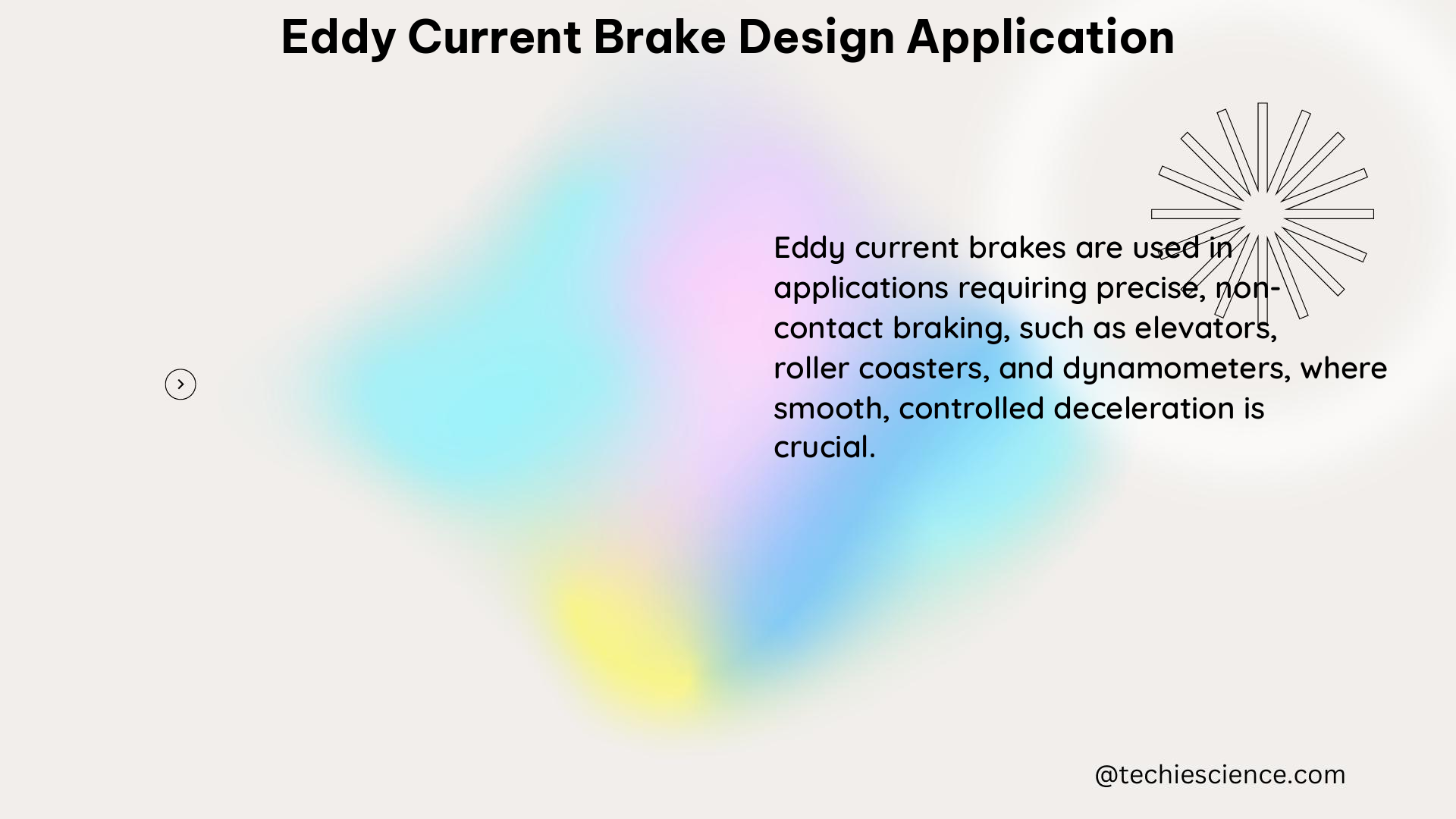Eddy current brakes are a fascinating application of electromagnetic induction, offering a unique and efficient way to slow down or stop moving objects. These brakes harness the power of induced currents to generate opposing magnetic fields, creating a braking force that can be precisely controlled and measured. In this comprehensive guide, we will delve into the intricacies of eddy current brake design, providing science students with a detailed playbook to understand and experiment with this technology.
Understanding the Principles of Eddy Current Brakes
Eddy current brakes work on the principle of electromagnetic induction, where a moving conductive material, such as a metal plate or disc, passes through a magnetic field. This interaction induces eddy currents within the conductive material, which in turn generate their own magnetic fields. These opposing magnetic fields create a braking force that opposes the motion of the moving object, effectively slowing it down or bringing it to a stop.
The strength of the eddy current brake can be quantified by the force it generates, which is proportional to the square of the velocity of the moving part, the magnetic field strength, and the area of the stationary part. This relationship can be expressed mathematically using the formula:
F = B^2 * A * v^2 / R
Where:
– F is the force generated by the eddy current brake (in Newtons)
– B is the magnetic field strength (in Teslas)
– A is the area of the stationary part (in square meters)
– v is the velocity of the moving part (in meters per second)
– R is the resistance of the stationary part (in ohms)
By understanding and applying this formula, you can design and optimize eddy current brakes for various applications.
Measuring the Strength of Eddy Current Brakes

To quantify the strength of an eddy current brake, you can measure several key parameters:
-
Damping Coefficient (b): This is a measure of the force generated by the eddy current brake. In the laboratory activity described in the references, the damping coefficient was found to range from 0.039 N s m^-1 to 0.378 N s m^-1, depending on the specific combination of track and magnet used.
-
Kinetic Friction Coefficient (μ): This is a measure of the force required to move the magnet along the track in the absence of an eddy current brake. In the same laboratory activity, the kinetic friction coefficient was found to range from 0.20 to 0.22.
-
Velocity (v): The velocity of the moving part, such as a magnet or a wheel, is a crucial parameter in determining the strength of the eddy current brake.
-
Magnetic Field Strength (B): The strength of the magnetic field generated by the stationary part, such as a metal plate or rail, is another important factor in the performance of the eddy current brake.
-
Area of the Stationary Part (A): The size and geometry of the stationary part, which interacts with the moving part, also contribute to the overall braking force.
-
Resistance of the Stationary Part (R): The electrical resistance of the stationary part, typically a conductive material like aluminum or copper, affects the induced eddy currents and the resulting braking force.
By measuring these parameters, you can not only quantify the strength of the eddy current brake but also use the formula F = B^2 * A * v^2 / R to calculate the expected braking force.
Designing a DIY Eddy Current Brake
To demonstrate the principles of eddy current braking, you can set up a simple DIY experiment using a neodymium magnet disc and an aluminum bar. Here’s how you can do it:
-
Materials: Obtain a neodymium magnet disc (e.g., 30 mm diameter, 5 mm thick, and approximately 40 grams) and an aluminum bar (e.g., 920 mm long, 40 mm wide, and 3 mm thick).
-
Experimental Setup: Place the aluminum bar on a flat surface. Release the neodymium magnet disc from a height and allow it to slide down the aluminum bar.
-
Measurements: Measure the time it takes for the magnet to slide down the aluminum bar. You can use this information to calculate the force generated by the eddy current brake using the formula:
F = m * g / t
Where:
– F is the force generated by the eddy current brake (in Newtons)
– m is the mass of the magnet (in kilograms)
– g is the acceleration due to gravity (9.8 m/s^2)
– t is the time it takes for the magnet to slide down the bar (in seconds)
- Magnetic Field Strength and Area: You can also measure the magnetic field strength of the neodymium magnet and the area of the aluminum bar to calculate the expected force using the formula:
F = B^2 * A * v^2 / R
Where:
– B is the magnetic field strength (in Teslas)
– A is the area of the aluminum bar (in square meters)
– v is the velocity of the magnet (in meters per second)
– R is the resistance of the aluminum bar (in ohms)
By performing this simple DIY experiment, you can gain a hands-on understanding of the principles of eddy current braking and explore the relationship between the various parameters that influence the braking force.
Advanced Applications of Eddy Current Brakes
Eddy current brakes have a wide range of applications beyond the simple DIY setup. Some advanced applications include:
-
Linear Electromagnetic Launchers: Eddy current brakes can be used in linear electromagnetic launchers, such as those used in maglev trains, to control the acceleration and deceleration of the moving object.
-
Vibration Damping: Eddy current brakes can be used to dampen vibrations in machinery, reducing the risk of damage and improving overall system performance.
-
Dynamometer Testing: Eddy current brakes are commonly used in dynamometers, which are devices used to measure the power output of engines or electric motors.
-
Magnetic Levitation: Eddy current brakes can be used in magnetic levitation systems, where the braking force is used to counteract the lifting force and maintain a stable levitation.
-
Regenerative Braking: In electric vehicles, eddy current brakes can be used in regenerative braking systems, where the kinetic energy of the vehicle is converted into electrical energy and stored in the battery.
These advanced applications often involve more complex designs and require a deeper understanding of electromagnetic principles, material properties, and system dynamics. As a science student, exploring these applications can provide valuable insights into the versatility and potential of eddy current brakes.
Conclusion
Eddy current brakes are a fascinating and versatile technology that offer a unique way to control the motion of moving objects. By understanding the underlying principles, measuring the key parameters, and designing simple DIY experiments, science students can gain a comprehensive understanding of eddy current brake design and its applications.
This guide has provided a detailed playbook for science students to explore the world of eddy current brakes, from the fundamental physics to the advanced applications. By mastering the concepts and techniques presented here, you can unlock new opportunities for research, innovation, and practical applications in various fields of science and engineering.
References
- J. A. Molina-Bolívar and A. J. Abella-Palacios, “A laboratory activity on the eddy current brake,” Eur. J. Phys., vol. 33, no. 3, pp. 697–707, 2012.
- J. A. Molina-Bolívar and A. J. Abella-Palacios, “A laboratory activity on the eddy current brake,” ResearchGate, 2012. [Online]. Available: https://www.researchgate.net/publication/254496903_A_laboratory_activity_on_the_eddy_current_brake.
- A. K. Singh, M. Ibraheem, and A. K. Sharma, “Parameter Identification of Eddy Current Braking System for Various Applications,” in Proceedings of the 2014 Innovative Applications of Computational Intelligence on Power, Energy and Controls with their Impact on Humanity (CIPECH), Ghaziabad, India, 2014, pp. 191–195.
- H. Li, M. Yang, and W. Hao, “Research of Novel Eddy-Current Brake System for Moving-Magnet Type Linear Electromagnetic Launchers,” in Proceedings of the 2019 Cross Strait Quad-Regional Radio Science and Wireless Technology Conference (CSQRWC), Taiyuan, China, 2019, pp. 1–3.
- [Online]. Available: https://electronics.stackexchange.com/questions/472827/how-strong-are-eddy-current-brakes.

I am Subrata, Ph.D. in Engineering, more specifically interested in Nuclear and Energy science related domains. I have multi-domain experience starting from Service Engineer for electronics drives and micro-controller to specialized R&D work. I have worked on various projects, including nuclear fission, fusion to solar photovoltaics, heater design, and other projects. I have a keen interest in the science domain, energy, electronics and instrumentation, and industrial automation, primarily because of the wide range of stimulating problems inherited to this field, and every day it’s changing with industrial demand. Our aim here is to exemplify these unconventional, complex science subjects in an easy and understandable to the point manner.